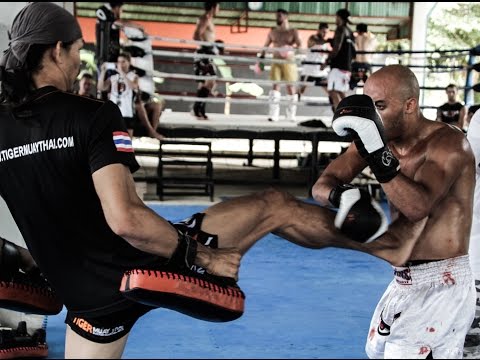The Best 2014 Tiger Muay Thai Team Tryout Documentary: Episode 2

My Muay Thai Training: Using savate to improve my Muay Thai game
I wrote a few weeks ago, I am recently back to Muay Thai training after a bit of an absence. So far, so good. Cardio is still terrible of course, but the technique is all working nicely, and I’m thoroughly enjoying being back in the gym. My time away from Muay Thai got me thinking about other striking arts and how they work together, which means I must make a confession here:
I cheated on Muay Thai.
I felt guilty about it. I’ve always been a bit of a Muay Thai snob, feeling like this is clearly the best overall striking style, and somewhat looking down on other arts with their silly spins and emphasis on forms. Muay Thai has always seemed the most pure, the most logical – the one that best works in an actual fighting situation. So it was with some trepidation that during my time away from my Muay Thai gym, I dabbled in a few classes in savate.

Savate, for those unfamilair with it (or who only think of GSP in Captain America) is a French style based on pinpoint kicks with a shoe. Unlike Muay Thai, where a kick lands with the heavy thud of your shin, savate kicks tend to be more precise, landing often with the pointed toe (again, in a shoe – otherwise you break your toes every time) in a sensitive area. There’s also a significantly greater emphasis on movement. That’s a grossly oversimplified version of savate, but it gives you the broad strokes.
At first, I found savate to be somewhat silly. Why strike with this tiny surface at a tiny target when you can just hurl your shin into someone’s thigh with maximum force? My trepidation was increased during a savate sparring session when my significantly more experienced partner continued to throw kicks to my thigh. With a lack of savate knowledge, and a Muay Thai base to fall back on, I did what my body knew to do – I lifted my leg and checked the kick. My partner was not happy, loudly proclaiming that I could have broken his foot and that checks were not allowed. Again, this felt silly to me. Checking a kick is effective, so why would it not be allowed?

[Quick side note here: I try to be a very responsible partner in the gym, but must admit that I did not feel too bad about his anger over my check. He had a lot of savate experience and was coming at me very aggressively during my 2nd class ever. Not a considerate move, and at that point, you get what you get. I’m a firm believer that when you are the experienced one in the gym, you go light and easy on the newbies, mainly because that’s polite, but also because if you go too hard, their untrained flailings are going to get one of you hurt. But I digress…]
This past week, back in the Muay Thai world, I found the value of that savate. As we worked a classic Ernesto Hoost combo (left hook to body, leg kick thrown at a downward angle) I found the savate helpful. Much like savate, with this kick, I was attacking a specific point, using my shinbone more like a sword than like a club. And this helped me answer my question about why you would throw a savate kick. Answer: because in some situations, a precise kick is more devastating. Think of a Muay Thai kick like hitting a tree with a baseball bat, and a savate kick like hitting a nail with a hammer. It takes more accuracy to use the hammer, but if you hit it right, it’s more effective. I brought that accuracy to the Hoost style leg kick, and the results were great.
Does this mean I am likely to go back to savate? Probably not. I still love my Muay Thai. But I have taken an aspect of the training and brought it in to improve my game, and for that, I appreciate the style.
Question for you other trainees: what have you brought in from one discipline to another, and has it worked well for you?

In this installment of the 2014 Tiger Muay Thai Tryout series, the athletes compete in some authentic Muay Thai training. Tiger Muay Thai invited 26 up and coming MMA and Muay Thai athletes from around the globe to compete against each other for a spot on our professional fight teams and a year’s scholarship training at our camp in the tropical land of Phuket, Thailand. Of the 26 invitees, only seven scholarships were given, five MMA and two Muay Thai. More episodes to come soon.
Film by Jeff Sainlar
http://www.jeffsainlar.com/Source: 2014 Tiger Muay Thai Team Tryout Documentary: Episode 2 – YouTube





